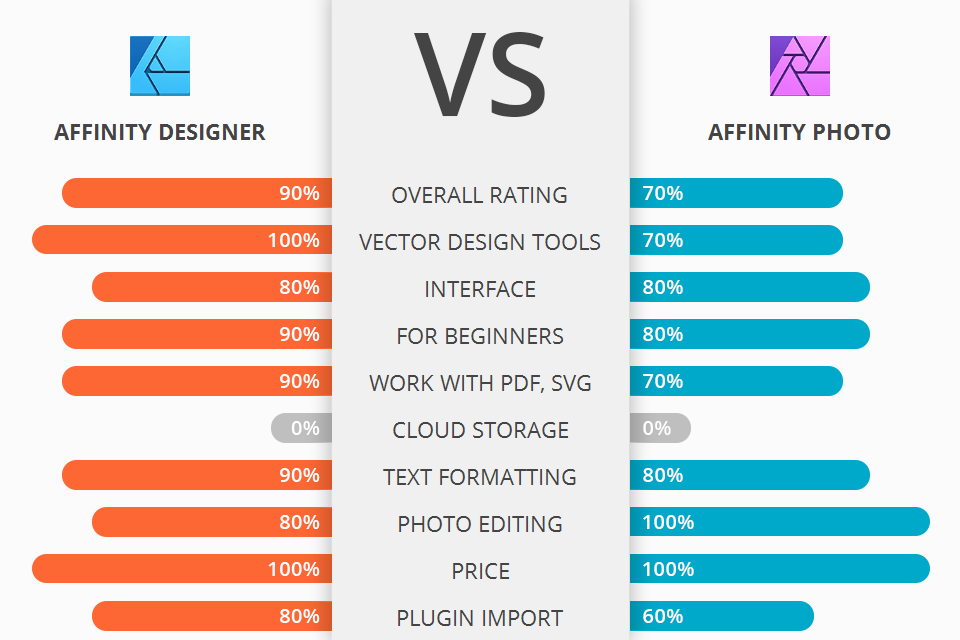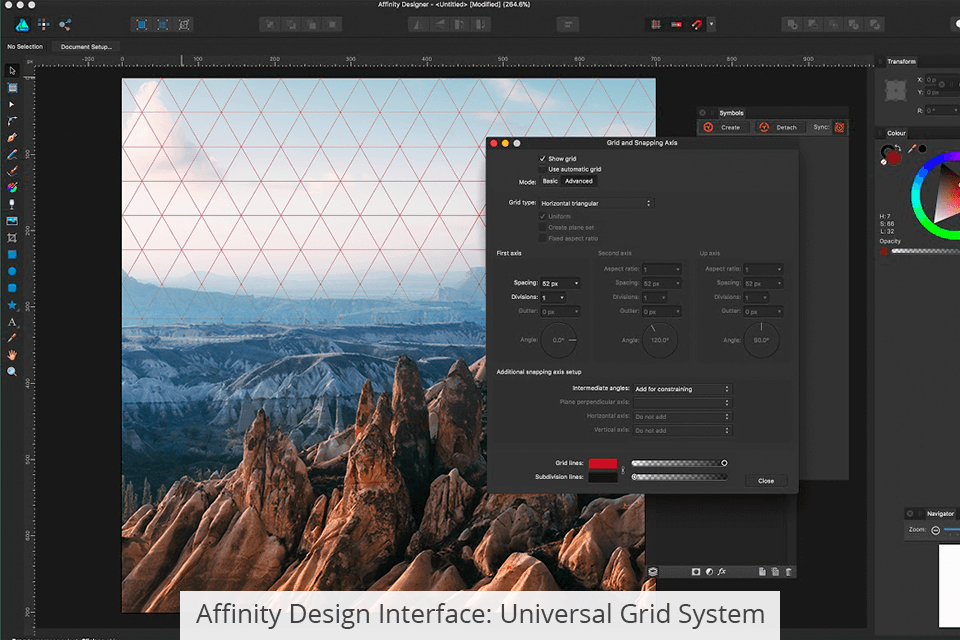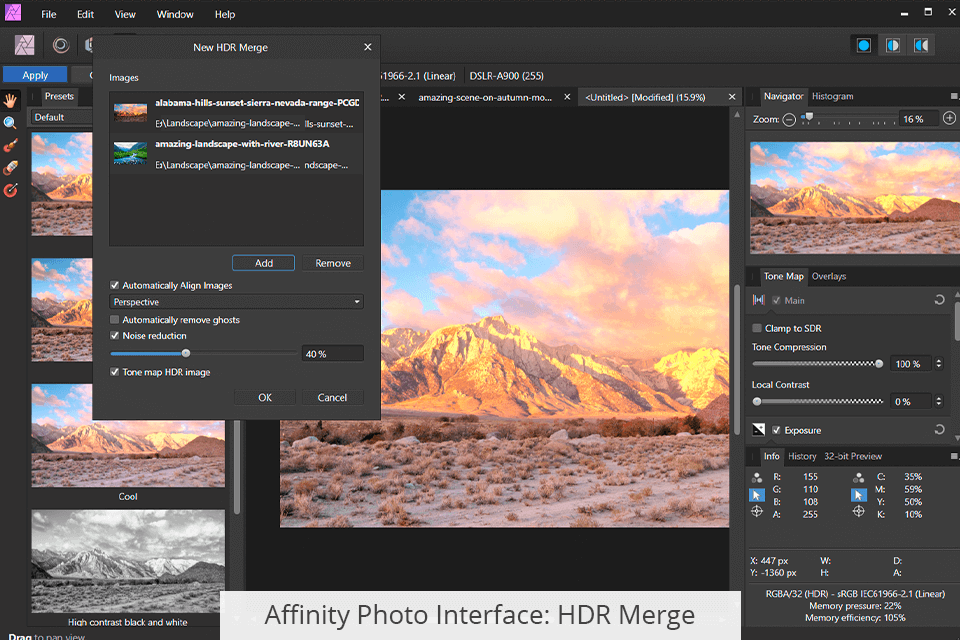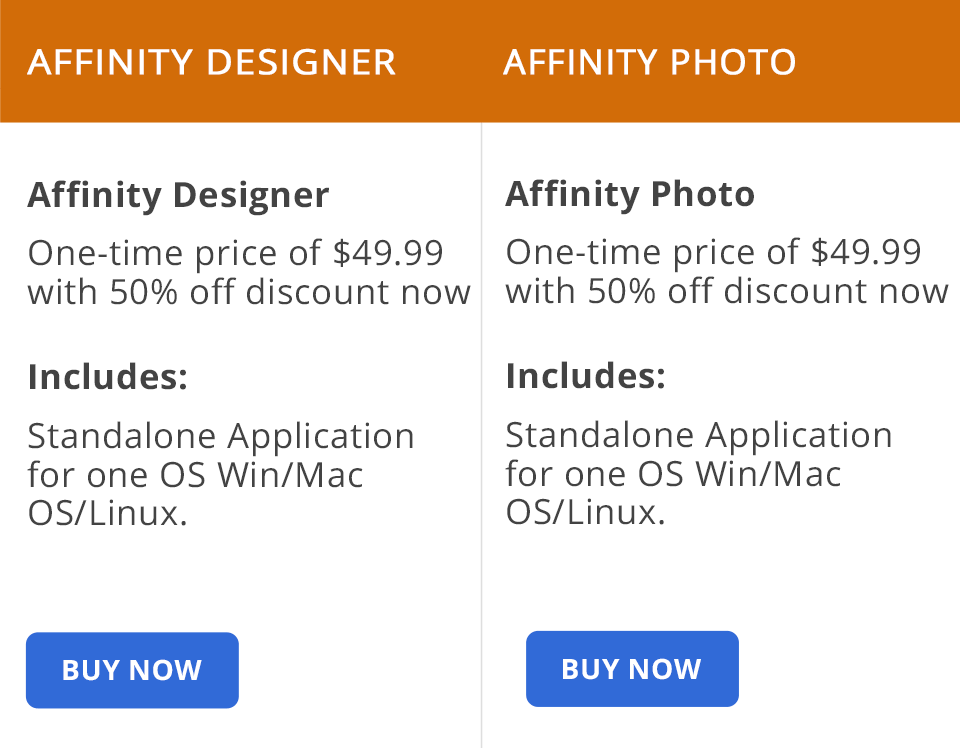Affinity Designer vs Affinity Photo are designed to work with raster and vector graphics. However, it depends only on your needs and requirements which software to opt for. Both programs are released by the same developer and are available on the official website of the company.
Affinity Designer is cross-platform graphics editing software that doesn’t contain any bells and whistles. This program is designed for professional purposes, so you can work on the tiniest details of your project. Affinity Designer supports the newest computer technologies. Being responsive and extremely flexible, it meets the needs even of the most demanding users.
Affinity Photo allows you to work with raster graphics. It is available for iOS, macOS and Windows. While offering impressive functionality, it requires powerful computing hardware for proper functioning. You can use it as a full-featured photo editor to develop your creative projects.
Super Zoom. It boasts impressive zoom capabilities for creating vector graphics and illustrations. You can work with projects of any complexity and zoom to over 1,000,000% for absolute accuracy. It is an indispensable tool especially if you design artboards with lots of detail.
Advanced Grids. The program includes a well-elaborated grid system that allows you to simplify your work when you develop visual content, such as icons or isometric video game graphics. Once you set up a grid, you can accurately adjust the spacing, subdivisions, angles and gutters.
Multitool. Affinity Designer offers pixel art environments and vector art environments. This allows you to mix vector and raster design and art techniques within one program. When you switch to a vector mode, you can do vector inking and coloring. Once you choose a pixel mode, you can make the most of raster brushes, select pixels and work with the Layers panel.
Ease of Use. It takes time to get familiar with the Affinity Designer interface, though it is pretty intuitive. Also, it is possible to go through several guides to understand the program’s capabilities.
Undo Mistakes. If you do a lot of mistakes and want to use a backup plan for your project, Affinity Designer is a great tool for that. You can press the Undo button up to 8,000 times. Also, it is possible to use history snapshots to define a stage in your session from which you want to restore your design. This means that you don’t need to click 8,000 times to restore an earlier version of your document, but you can do it if you choose to.
Compatibility issue. The program will import files in an AI format. However, thanks to its round-trip compatibility, it supports such file formats as PNG, GIF, PDF, JPEG, PSD, SVG, EPS or TIFF.
Doesn’t offer artboard management. This is a weak point of Affinity Designer. You can add artboards to a new document. However, the program doesn’t offer special features for artboard management.
Persona workflows. Affinity Designer has a Persona layout. It is necessary to enable the Draw Persona to create a new file. Then, you should choose the Pixel Persona to paint and adjust your project. The Export Persona allows you to export your design. Thus, to adjust any action, you will need to always switch between the Persona modes.
Advanced Text Editing. You can import a PSD file in Affinity Photo from Photoshop and do manipulations with the text box. However, it is impossible to edit a text. The software incorporates its own text tools, such as Artistic Text and Frame Text.
With the Artistic Text tool, you can decorate some phrases in your document, and the Frame Text tool allows you to work with longer text entries. You can also edit the text in more detail using an OpenType feature. This allows you to mix vector and raster design and art techniques within one program. which gives the program another point in Affinity Designer vs Illustrator stand-off. Nevertheless, you can enjoy advanced kerning and tracking.
HDR Merge. If the scene requires merging several exposures into a single image, you can take advantage of this tool. It is possible to choose an unlimited number of source pictures and automatically align layers for merging. It will take you several minutes to do this task unless you have a high-tech computer. Different focus distances can be combined together to create an image with a greater depth of field.
Flawless retouching. Whether you want to quickly tweak your picture or do deep photo retouching, Affinity Photo has all the necessary tools to accomplish your creative goals. It is possible to create silky skin tones using frequency separation. With the help of the Inpainting Brush Tool, it is possible to remove unnecessary elements in the picture. Also, you can take advantage of such tools as Dodge, Burn, Clone, Patch and Blemish Removal.
Live filter layers. Affinity Photo features non-destructive live filter layers that can be complemented with various effects, like perspective correction, blur, lighting and distortions. It is possible to adjust these layers at any time.
You can apply the effects to an individual layer or a bundle of layers and enable full-resolution preview to ensure correct image editing.
Photo Output. The Export Persona allows you to create custom export areas to choose the output from your file, but it doesn’t include an export option. You should select File > Export from the menu. It is possible to save your projects in multiple file formats except for the AI format.
Besides, Affinity Photo includes other useful features, such as soft proofing, color management and the ability to import files into the ICC printer color profiles.
Limited number of plug-ins. The ability to use plug-ins has been recently added to Affinity Photo, so not many options are compatible with the program. Thus, it will be rather challenging to work with new products, since Affinity Photo updates are not as frequent and simple as in Photoshop.
Can’t save previous settings. The program doesn’t allow you to save the settings of a filter you’ve already adjusted. Each time you want to work with a filter, you should modify it again. It takes a lot of time to always change the default settings to those you need.
Issues when working with graphics tablets. If you use a mobile Affinity Photo version and work with graphics tablets, you can experience some difficulties with brush properties, such as tilt and pressure. Customizing a brush tool may seem a real challenge, so it is more convenient to use a mouse than a tablet.
Compared to Adobe products, the Photo’s and Designer’s price brackets are more tempting. You can buy one product only for $49.99. All Affinity products are now 50% off, so the price of one program is $24.99.
The developer allows you to install software on an unlimited number of computers. However, if you purchase a Windows version, you can’t install it on macOS. One license is suitable only for a particular operating system. If you want to use an Affinity Photo and Designer on your iPad, you should purchase a separate license as well.
Although these two programs cater to the needs of different categories of users, they have pretty similar sets of tools. Affinity Designer is an excellent alternative to Adobe Illustrator or Inkscape, while Affinity Photo has a lot of similar features with Photoshop and GIMP. With Affinity Designer, you can perform basic image editing, and Affinity Photo allows you to create simple designs.
So, before choosing between Affinity Designer vs Affinity Photo, you should understand your goals, whether you are going to edit photos or produce professional-looking designs. Anyway, both programs offer free trials, so you can test a product before making a purchase.
Affinity Designer is a full-featured vector graphics editor with a complete set of tools for drawing objects, brushes, well-elaborated text tools and advanced color grading features. The program supports printing and web design standards.
Affinity Photo is a perfect choice for advanced photo editing suitable for professional use. With Affinity Photo, you can create panoramas and HDR images and take advantage of digital painting tools. The program supports RAW file format for deeper photo editing.





